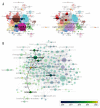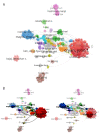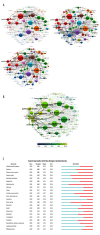Bibliometric Visualization Analysis of Microbiome-Gut-Brain Axis from 2004 to 2020
- PMID: 35568968
- PMCID: PMC9119018
- DOI: 10.12659/MSM.936037
Bibliometric Visualization Analysis of Microbiome-Gut-Brain Axis from 2004 to 2020
Abstract
BACKGROUND The microbiome-gut-brain axis (MGBA) is the biochemical signal of the digestive tract and central nervous system. MGBA disorders have been increasingly involved in the pathological process of neurological diseases. This study aimed to investigate the research hot spots of MGBA from 2004 to 2020. MATERIAL AND METHODS Using bibliometric analysis from the Web of Science Core Collection (WOSCC) database, 3993 documents on the MGBA were retrieved and visual analysis was conducted. RESULTS The MGBA has received attention worldwide and will continue to be a research hot spot. Emerging research organizations and scholars of the MGBA and the research of John F. Cryan and colleagues from Ireland in the MGBA have been recognized by many scholars. However, the research of Chinese scholars and organizations appeared to have less impact due to lack of research innovation and collaboration with other countries/regions. Keyword analysis showed that neuroinflammation was a hot spot and that eminent scholars had begun to work in the field of MGBA. CONCLUSIONS This work provided an overall view of the literature on the MGBA worldwide, and the analysis provided a comprehensive overview of MGBA research. It further revealed the interaction between the gut microbiota (eg, Akkermansia, Parabacteroides) and the specific regulatory network of the gut microbiota and metabolites, neuroinflammation, and neural networks, which can facilitate the development of effective treatment strategies using microbiota for targeting neuroinflammation and conducting large-scale clinical trials of neurological diseases.
Conflict of interest statement
Figures





Similar articles
-
Mapping trends and hotspot regarding gastrointestinal microbiome and neuroscience: A bibliometric analysis of global research (2002-2022).Front Neurosci. 2022 Nov 17;16:1048565. doi: 10.3389/fnins.2022.1048565. eCollection 2022. Front Neurosci. 2022. PMID: 36466165 Free PMC article.
-
Global research trends in microbiome-gut-brain axis during 2009-2018: a bibliometric and visualized study.BMC Gastroenterol. 2019 Aug 30;19(1):158. doi: 10.1186/s12876-019-1076-z. BMC Gastroenterol. 2019. PMID: 31470803 Free PMC article.
-
Cross-talk between adipose tissue and microbiota-gut-brain-axis in brain development and neurological disorder.Brain Res. 2024 Dec 1;1844:149176. doi: 10.1016/j.brainres.2024.149176. Epub 2024 Aug 23. Brain Res. 2024. PMID: 39182900 Review.
-
Crosstalk between adipose tissue and the microbiota-gut-brain axis in metabolic diseases.Int J Biol Sci. 2022 Feb 7;18(4):1706-1723. doi: 10.7150/ijbs.68786. eCollection 2022. Int J Biol Sci. 2022. PMID: 35280695 Free PMC article. Review.
-
Research trend of microbiota-gut-brain axis in Alzheimer's disease based on CiteSpace (2012-2021): A bibliometrics analysis of 608 articles.Front Aging Neurosci. 2022 Nov 22;14:1036120. doi: 10.3389/fnagi.2022.1036120. eCollection 2022. Front Aging Neurosci. 2022. PMID: 36483116 Free PMC article.
Cited by
-
Bibliometric analysis of scientific outputs on psychobiotics: Strengthening the food and mood connection.Medicine (Baltimore). 2024 Aug 9;103(32):e39238. doi: 10.1097/MD.0000000000039238. Medicine (Baltimore). 2024. PMID: 39121264 Free PMC article.
-
Brain-gut axis and psychiatric disorders: A perspective from bibliometric and visual analysis.Front Immunol. 2022 Nov 16;13:1047007. doi: 10.3389/fimmu.2022.1047007. eCollection 2022. Front Immunol. 2022. PMID: 36466907 Free PMC article.
-
Deciphering the Influence of Estradiol and Estrogen Receptors on Cognitive Function: A Bibliometric Analysis and Emerging Research Trends.Med Sci Monit. 2023 Jun 10;29:e939676. doi: 10.12659/MSM.939676. Med Sci Monit. 2023. PMID: 37300249 Free PMC article.
-
Mapping trends and hotspot regarding gastrointestinal microbiome and neuroscience: A bibliometric analysis of global research (2002-2022).Front Neurosci. 2022 Nov 17;16:1048565. doi: 10.3389/fnins.2022.1048565. eCollection 2022. Front Neurosci. 2022. PMID: 36466165 Free PMC article.
-
The Microbiome-Gut-Brain Axis and Dementia: A Bibliometric Analysis.Int J Environ Res Public Health. 2022 Dec 9;19(24):16549. doi: 10.3390/ijerph192416549. Int J Environ Res Public Health. 2022. PMID: 36554429 Free PMC article.
References
Publication types
MeSH terms
LinkOut - more resources
Full Text Sources
Medical

